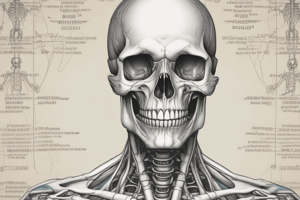Podcast
Questions and Answers
What are trabeculae?
What are trabeculae?
- Cells responsible for producing new bone matrix
- Living cells embedded within the bone matrix
- Rods of bone within cancellous bone providing structural support (correct)
- Cells responsible for breaking down old bone matrix
Which cells are responsible for breaking down old bone matrix?
Which cells are responsible for breaking down old bone matrix?
- Osteocytes
- Osteoblasts
- Bone marrow cells
- Osteoclasts (correct)
What is the function of osteoblasts?
What is the function of osteoblasts?
- Producing new bone matrix and mineralizing it (correct)
- Breaking down old bone matrix
- Producing blood cells
- Monitoring and regulating bone remodeling
Where is bone marrow found in the body?
Where is bone marrow found in the body?
What is the main function of bones in the human body?
What is the main function of bones in the human body?
What is the role of osteocytes in bone health?
What is the role of osteocytes in bone health?
What is the function of long bones in the human body?
What is the function of long bones in the human body?
Which bone type is primarily responsible for providing protection for vital organs?
Which bone type is primarily responsible for providing protection for vital organs?
Where is cancellous bone (spongy bone) primarily found?
Where is cancellous bone (spongy bone) primarily found?
What is the function of compact bone in the skeletal system?
What is the function of compact bone in the skeletal system?
Which bone structure serves as an attachment point for tendons and ligaments?
Which bone structure serves as an attachment point for tendons and ligaments?
What is the primary characteristic that distinguishes long bones from flat bones?
What is the primary characteristic that distinguishes long bones from flat bones?
Flashcards
Long Bones
Long Bones
Longer than they are wide with a hollow interior, primarily for movement and muscle attachment.
Flat Bones
Flat Bones
Thin and wide bones that protect vital organs and provide muscle attachment points.
Periosteum
Periosteum
A membrane covering the outer surface of bones, serving as an attachment point for tendons and ligaments.
Compact Bone
Compact Bone
Signup and view all the flashcards
Cancellous Bone (Spongy Bone)
Cancellous Bone (Spongy Bone)
Signup and view all the flashcards
Bone Marrow
Bone Marrow
Signup and view all the flashcards
Osteocytes
Osteocytes
Signup and view all the flashcards
Osteoblasts
Osteoblasts
Signup and view all the flashcards
Osteoclasts
Osteoclasts
Signup and view all the flashcards
Bones and Movement
Bones and Movement
Signup and view all the flashcards
Mineral Storage in Bones
Mineral Storage in Bones
Signup and view all the flashcards
Blood Cell Production
Blood Cell Production
Signup and view all the flashcards
Study Notes
Anatomy and Structure of Bones
Bones are the foundation of our skeletal system, providing structure, support, and protection for our bodies. They're more than just rigid, inanimate objects. Bones are dynamic, living tissues that undergo constant processes to maintain their health and function.
Types of Bones
Bones come in two main types: long bones and flat bones. Long bones, such as the femur (thigh bone) and the tibia and fibula (lower leg bones), are longer than they are wide and have a hollow interior. These bones primarily function for movement and serve as attachment points for muscles and tendons. Flat bones, like the bones of the skull and the scapula (shoulder blade), are thin and wide, providing protection for vital organs and attachment points for muscles.
Bone Anatomy
Bones are composed of several types of tissues and structures, including:
- Periosteum: A thin layer of membrane that covers the outer surface of bones and serves as an attachment point for tendons and ligaments.
- Compact bone: Found primarily in the outer layer of bones, it's dense, hard, and provides structural support and protection.
- Cancellous bone (spongy bone): Found primarily in the interior of flat bones and in the ends of long bones, it's lighter, more porous, and helps reduce bone weight while maintaining strength.
- Haversian system: A network of canals within compact bone that contain blood vessels, nerves, and lymphatic vessels.
- Trabeculae: Rods of bone within cancellous bone that provide structural support.
- Bone marrow: A soft, fatty tissue found in the hollow centers of long bones that produces blood cells.
Bone Structure
Bones have a unique structure characterized by two main types of bone cells:
- Osteocytes: Living cells embedded within the bone matrix that monitor and regulate bone remodeling and maintenance.
- Osteoblasts: Cells responsible for producing new bone matrix and mineralizing it.
- Osteoclasts: Cells responsible for breaking down old bone matrix and removing it.
These cells work together to maintain bone health through a continuous process of bone modeling and remodeling.
Bone Function
Bones serve several essential functions in the human body:
- Support and protection: Bones provide structural support for the body and protect vital organs like the brain and spinal cord.
- Movement: Bones act as levers for muscles, allowing us to move our bodies.
- Storage: Bones store essential minerals, such as calcium, phosphate, and magnesium, that are important for overall health and bone strength.
- Production of blood cells: Red and white blood cells are produced in the bone marrow, which is found in the hollow centers of long bones.
Understanding the anatomy and structure of bones is crucial for appreciating their essential functions and the importance of maintaining healthy bones throughout our lives.
Studying That Suits You
Use AI to generate personalized quizzes and flashcards to suit your learning preferences.




